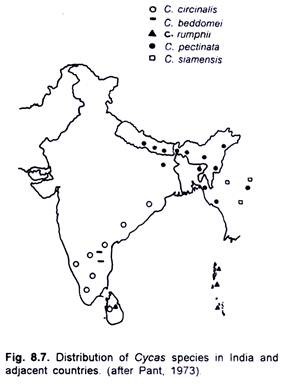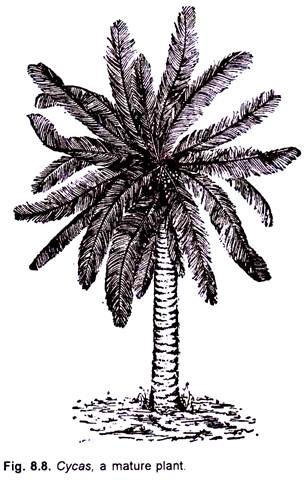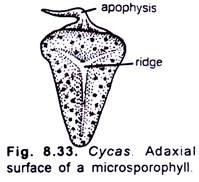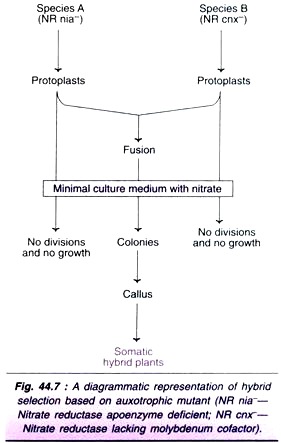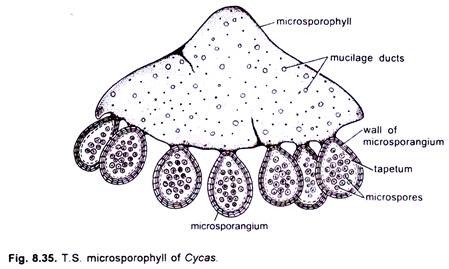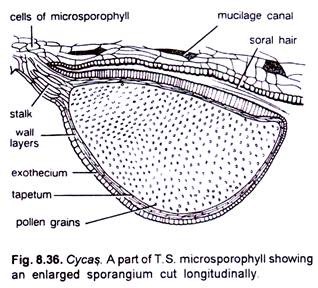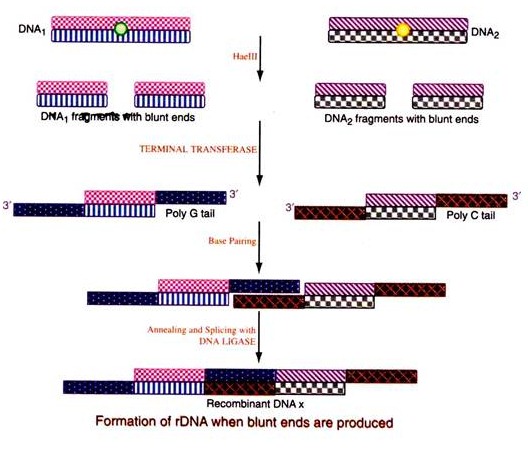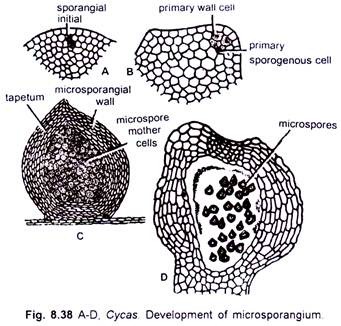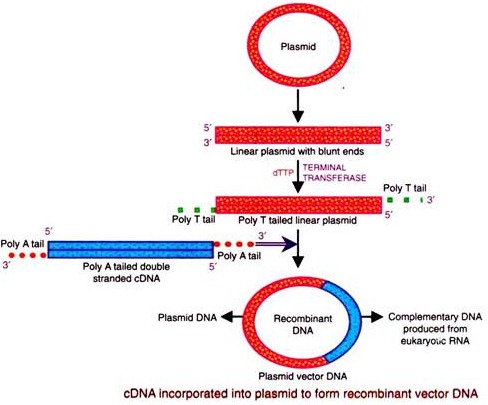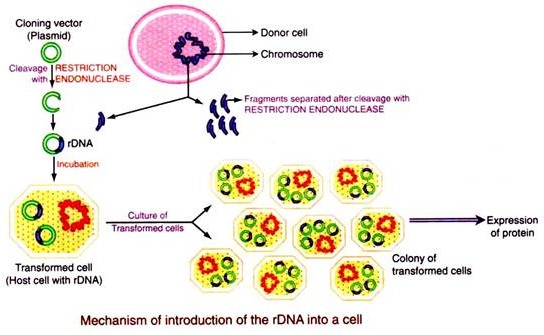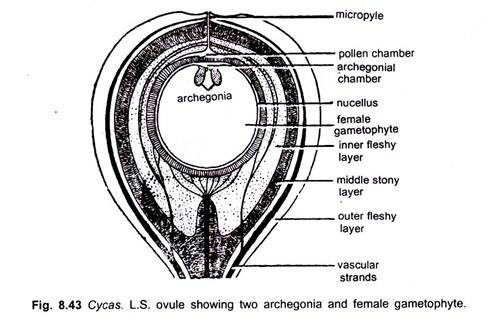In this article we will discuss about Cycas. After reading this article you will learn about: 1. Distribution of Cycas 2. General Morphology of Cycas 3. Anatomy of Vegetative Parts 4. Reproduction 5. Economic Importance.
Contents:
- Distribution of Cycas
- General Morphology of Cycas
- Anatomy of Vegetative Parts of Cycas
- Reproduction of Cycas
- Economic Importance of Cycas
Contents
1. Distribution of Cycas:
Cycas, the largest genus among the Old World Cycads, is the most widely distributed genus of order Cycadales. It is distributed in Japan, Australia, India, Indochina, China, Mauritius, Africa, Nepal, Bangladesh, Sri Lanka and Myanmar. In India, Cycas grows naturally in Orissa, Assam, Meghalaya, Tamil Nadu, Karnataka and Andaman and Nicobar Islands (Fig. 8.7).
Cycas is represented by 15 species but according to Willis (1966) there are 20 species of the genus. Schuster (1932), however, recognizes only 8 species, mentioning for the rest as the forms, varieties or sub-species of the other species.
Besides Cycas circinalis, C pectinata, C. rumphii and C. beddomei, which occur in the wild state in India, C. revoluta and C. siamensis are such species which are cultivated commonly in the Indian gardens. Cycas revoluta is the most commonly cultivated species of the Indian gardens.
Some Indian Species:
1. Cycas beddomei Dyre:
A small shrub with a trunk of about 40 cm long. It is distributed in Andhra Pradesh, Madras, Calicut, etc. Leaves are large and reach up to 1 metre in length with quadrangular rachis. Leaflets are narrow and linear. Male cones are oblong to ovoid, bearing a short peduncle. Megasporophylls are ovate, lanceolate with dentate margins. They are produced in November-December.
2. Cycas circinalis Linn:
Commonly called ‘Jangli-madan-mast-ka-Phul’ (Hindi) or ‘Kamakshi’ (Telugu), C. circinalis is commonly distributed in western part of Peninsular India, Western Ghat and Orissa Hills in India. It is often cultivated in Indian gardens.
It is an evergreen tree bearing leaves of 1.5 to 3 metres in length with about 100 pairs of leaflets. Leaflets are linear-lanceolate with flat margin and acuminate apex. Upper sterile part of megasporophyll is longer than broad with dentate margins. Male cones are cylindrical to ovoid with a short peduncle. Megasporophylls contain brown tomentose hairs.
3. Cycas pectinata Griff:
It is distributed in Sikkim, Assam, Manipur and Someshwar Hills of Bihar in India along with some other countries including Nepal and Bangladesh. Its trunk ranges from 1.5 to 2.5 metres in length.
Leaves attain a length of about 1.5 to 2 metres. Leaflets are narrow, linear, tapering into a minute spine and measure from 14 to 25 cm. in length. Male cone is cylindrical-ovoid. The upper part of the megasporophyll is as broad as long.
4. Cycas revoluta Thunb:
It grows in wild state in Japan, China and Taiwan and is widely cultivated in several parts of the world, including India. It is so named because of the revoluted margins of its leaflets It is a palm-like tree, the trunk of which reaches up to 2 metres in length. Male cones are cylindrical or ovoid-oblong. Megasporophylls are 10-25 cm in length and densely tomentose
5. Cycas Rumphii Miq:
It is an evergreen palm-like tree distributed in Andaman and Nicobar Islands of India along with Sri Lanka, Malaysia and Australia. Its trunk reaches up to 4 metres while the leaves attain a length of 1-2 metres with 50 to 100 or more pairs of leaflets. Male cone is shortly stalked and ellipsoidal to oblong in shape. Megasporophylls are ovate-lanceolate with many small teeth.
6. Cycas siamensis Miq:
It is found in Myanmar, Thailand, China and Laos. It is a palm like tree. The leaves reach about 1 metre in length. Leaflets are narrow, linear with mucronate or acuminate apex. Male cone is ovoid oblong.
Megasporophyll’s sterile blade is as broad as long with usually only 2 ovules. Burkill (1933) considered Cycas siamensis as a geographical form of C. pectinata. Pant and Nautial (1963) also consider the two species similar, mainly because of their epidermal and anatomical studies.
2. General Morphology of Cycas:
Cycas is a palm-like, evergreen plant (Fig. 8.8). Prior to the anatomical studies of the stem of Cycas revoluta by Brongniart (1829), the Cycas was actually considered a palm. The plant body consists of a columnar aerial trunk with a crown of pinnately compound leaves as its top.
According of Eichler (1889), Coulter and Chamberlain (1910), Schuster (1932) and others, a tap root system persists in the adult plant, but according to Worsdell (1906) the tap roots are soon replaced by adventitious roots.
Roots:
Roots in Cycas are of two types, i.e., normal tap roots forming a tap root system, and coralloid roots. Normal tap-roots are positively geotropic, grow deep into the soil and generally possess no root hairs. Their function is to fix the plant in the soil and to absorb water and other minerals.
From the normal roots develop some lateral branches near the ground surface. These lateral roots get infected with some bacteria, fungi and algae, and are called coralloid roots (Fig. 8.9). They grow- first horizontally in the soil and become swollen at their tips.
They divide repeatedly to form big bunches of greenish or brownish structures, which are coral like in appearance. They divide dichotomously, come out of the soil on the ground surface and are phototrophic in nature. Young plants bear more coralloid roots than the older ones.
Recently, Pant and Das (1990) reported non-coralloid aerial roots in Cycas circinalis, C. revoluta and C. rumphii. The charactenstic algal zone of coralloid roots is absent in these roots. These are positively geotropic, adventitious and develop from the lower sides of leaf bases or bulbils when they are still attached to the plant.
Stem:
The stem is thick, woody and usually un-branched. It is tuberous when young but columnar, erect and stout at maturity. Branching in stem (Fig. 8.10) is also not rare after the plants have reached a certain age. The aerial part of the trunk remains covered by a thick armour of large and small rhomboidai leaf bases.
These occur regularly in alternate bands (Fig. 8 .11). The larger leaf bases represent the bases of foliage leaves, while the smaller ones are the bases of scaly leaves in male plants and scales and megasporophylls in female plants. The age of the plant can be calculated by counting the number of crowns of leaves and megasporophylls which are produced every year.
Among all Cycas species, C. media is tallest, attaining a height up to 20 metres. Regarding the age of Cycas, the plants can survive for a long period. C. circinalis, if allowed to grow undisturbed, may attain an age of 100 years or even more.
Leaves:
Two types of leaves are present in Cycas. These are green, assimilatory ox foliage leaves, and scaly leaves or cataphylls.
1. Foliage Leaves or Assimilatory Fronds:
These are green, large, pinnately compound and stout leaves with a spiny petiole and large, strong rachis. They are produced at the apex of the stem in the form of crown. The rachis bears many leaflets.
With the help of a transversely expanded rhomboidai leaf base, a leaf remains attached with the stem Two rows of strong and stiff spines are present on the petiole. These spines gradually transform into two rows of pinnae towards the upper side of the leaf (Fig. 8.12).
Pant (1953) reported many abnormalities in Cycas leaves. Author, along with two of his colleagues, also reported many abnormalities in the vegetative parts of an year-old plant of Cycas circinalis growing in the Botanical Garden of Meerut College, Meerut.
Cycas leaf is very large and may reach up to 3 metres in length in some species such as C. thouarsii. Two rows of pinnae on the leaves may be alternate or opposite. The number of pinnae varies in different species. As many as hundred pairs of pinnae may be present in a mature leaf.
Each pinna is sessile, elongated, ovate or lanceolate in shape with a spiny or acute apex. Pinnae are repeatedly and deeply dichotomized in C. micholitzii (Fig. 8.13). Each pinna or of leaflet contains a midrib without any lateral branching.
Forking of the midvein of the leaflet has been reported in C. circinalis by author in 1976. Margins of the leaflets are revolute in C. revoluta and C. beddomei, while in C. rumphii and C. circinalis they are flat.
According to Chamberlain (1935) the “vernation is circinate in the midrib and pinnules of Cycas”. Leaves, when young, have circinately coiled pinnae like those of ferns (Fig. 8.14). Very young parts of Cycas are also covered by fern-like hairs or ramenta.
2. Scaly Leaves or Cataphylls:
These are dry, brown-coloured, somewhat triangular leaves with their one end pointed. They are present at the apex of the stem and remain covered with several ramental hairs (Fig. 8.15).
3. Anatomy of Vegetative Parts of Cycas:
(i) Normal Root (Young):
It is circular in outline and resembles structurally with dicotyledons (Fig. 8.16). Outermost layer is epiblema or exodermis, which surrounds the large parenchymatous cortex. Epiblema consists of tangentially elongated cells. From some of its cells arise root hairs.
In the wide zone of parenchymatous cortex there are present many intercellular spaces. Cells of the cortex remain filled with starch. Some tannin-filled cells, mucilage cells and sometimes sphaeraphides are also present in the cortex. The cortex is delimited by a single- layered endodermis. Casparian steps are present in the barrel-shaped cells of the endodermis.
Endodermis is followed by multilayered pericycle. Xylem and phloem bundles in the roots are radially arranged, i.e. present on different radii. The roots are usually diarch but sometimes the number of protoxylem strands range between 3 to 8.
The protoxylem consists of spiral tracheids while the metaxylem consists of scalariform tracheids. Vessels are absent. Phloem is present alternately with xylem groups and consists of sieve tubes and phloem parenchyma. Pith is generally absent.
(ii) Normal Root (old) Showing Secondary Growth:
The older roots (Fig. 8.17) undergo secondary growth. The cambium cuts secondary phloem towards the outer side and secondary xylem towards the inner side. After sometime the pericycle cells also become meristematic and form a complete cambial ring.
The secondary xylem consists of radial rows of tracheids separated by parenchymatous cells. The crushed primary phloem is present in the form of dark streaks outside the secondary phloem. The secondary xylem is manoxvlic and contains many multiseriate rays.
Periderm starts to develop in the cortex of old roots. Some of the cells of the outermost cortical region start to become meristematic and function as cork cambium. It cuts cork towards outer side and secondary cortex towards inner side. Cork cells are dead and remain filled with subenn. Cycas roots often show two layers of periderm (Fig. 8.17).
Epiblema is ruptured and there are no root hairs in the older roots.
(iii) Coralloid Root:
Anatomically, the coralloid roots (Fig. 8.18) resemble normal roots except some under mentioned differences:
1. The secondary vascular tissue in coralloid roots is either totally absent or poorly-developed.
2. The cortex is wider in comparison with the normal root.
3. Presence of a greenish algal-zone in the middle of the cortex. But according to Chaudhary and Akhtar (1931) the algal-zone is not of universal occurrence in the coralloid roots of Cycas. It may be absent in such coralloid roots which go very deep in the soil. According to these workers only those coralloid roots are negatively geotropic which are infected by algal members.
Algal-zone consists of radially elongated, large, thin-walled cells having large intercellular spaces occupied by algae. Life (1901) opined that these spaces are formed because of the retardation of growth of such cells which are already infected by fungi and bacteria.
Such infected cells cannot keep pace with the neighbouring cells, and a tension is produced which results in the formation of air spaces by breaking of certain cells. These spaces are further widened by the algal infection. But according to Chaudhary and Akhtar (1931) the alga is mainly responsible for the formation of these large intercellular spaces.
Following members have been reported from the algal zone of coralloid roots:
Anabaena cycadae, Nostoc punctiforme, Oscillatoria, Azotobacter, Pseudomonas radicicola and even a few fungi. According to Kubitzki (1990) blue green algae or Cyanoba cteria (Anabaena, Nostoc and Calothrix) may rarely be present intracellularly (i.e. inside the cell) in the coralloid roots of Cycas. He opined that these algae fix nitrogen and promote the growth of host plant.
Due to the presence of blue-green algal members and some nitrogen-fixing bacteria, the function assigned to the coralloid roots is chiefly the nitrogen fixation. The presence and structure of endodermis, pericycle and vascular bundles in the coralloid roots are similar to that of normal roots. The xylem is exarch and triarch.
(iv) Stem:
Similar to root, the stem of Cycas also resembles internally with a dicotyledonous stem.
It shows the following anatomical features:
Epidermis is the outermost layer consisting of compactly arranged thick- walled cells. Presence of several persistent leaf bases makes the epidermis a discontinuous and ruptured layer. Cortex is large and consists of thin- walled, parenchymatous cells, filled densely with starch grains. It contains numerous mucilaginous canals and girdle traces.
Each mucilage canal is lined with many radially elongated epithelial or secretory cells (Fig. 8.19). Medullary rays connect the mucilage canals of the cortex with that of the pith Starch in the parenchymatous cells of the cortex is the source of ‘sago’. Endodermis and pericycle are not clearly demarcated.
Numerous vascular bundles remain arranged in a ring. The stele is ectophloic siphonostele. Each vascular bundle is conjoint, collateral, open and endarch (Fig. 8.20). The xylem consists of tracheids and xylem parenchyma (Fig. 8.21).
Protoxylem contains tracheids with spiral thickenings while the metaxylem has scalariform thickenings with bordered pits. Vessels are absent. The phloem is located outside the xylem and consists of sieve tubes and phloem parenchyma. Companion cells are absent.
Between the xylem and phloem lies the primary cambium, which remains active only for a short period. It is soon replaced by another ring of secondary cambium somewhere in the cortex. These successive cambial rings form 2-14 different vascular rings showing polyxylic condition in the old stem (Fig. 8.22).
Several broad and well-developed medullary rays are present between the vascular bundles. Pith is large, well-developed and parenchymatous. It contains many mucilaginous canals.
(v) Leaf Traces:
The leaf traces remain scattered in the cortical region of the stem and constitute the vascular supply to the leaves from the main vascular cylinder. Normally, there are four leaf traces which form the vascular supply to the leaf. Two of these are direct traces, while the remaining two axe girdle traces (Fig. 8.23).
The direct traces originate from the vascular cylinder lying in front of the leaf base while the girdle traces develop from the vascular cylinder lying opposite to that of direct traces. They proceed together and curve soon in opposite directions, and by girdling round the vascular cylinder they enter in the leaf base.
In the cortical region the girdle traces also remain connected with other leaf traces. At the time of their entrance in the petiole, the leaf trace bundles subdivide and form many petiole bundles. Such type of unique girdle traces of Cycas, which also occur in Magnoliaceae. show a close relationship of Cycadales of Gymnosperms and Magnoliaceae of dicotyledons.
(vi) Secondary Growth:
It is similar to that of dicotyledons. In the beginning, Cycas is monoxylic, i.e. contains a single ring of vascular bundles. But one or more concentric rings of vascular bundles appear outside the primary ring of bundles in the older stems showing polyxylic condition (Fig. 8.24)
By the activity of inter-fascicular and intra-fascicular cambia, which unite to form a cambium ring, the secondary growth is initiated. This cambium ring cuts secondary phloem towards outer side and secondary xylem towards inner side. Well-developed medullary rays traverse through the so-formed secondary vascular tissue.
After a short while this cambium ring stops functioning and a second cambium ring develops either in the parenchymatous cortex or in the region of pericycle This cambium ring also behaves in the similar fashion.
In this fashion, as many as 14 rings of vascular tissue may develop in the stem of Cycas pectinata of about 20 cm diameter showing polyxylic condition. Seward (1917) reported 12 such rings in the stem of C. media of about 30 cm diameter, and Schuster (1932) reported 22 such rings in the stem of C. rumphii having a diameter of about 85 cm.
Cambial rings towards the periphery of the stem form lesser number of vascular bundles. The cork cambium develops on the outer region of the cortex and cuts cork towards outer side and secondary cortex towards inner side.
(vii) Rachis:
The outline of transverse section is rhomboidal in the basal region of the rachis, biconvex in the middle cambium and roughly cylindrical at the tip region or at the apex of the rachis. Two arms of the bases of leaflets are present on the rachis, one on each side (Fig. 8.25).
In T.S. the rachis reveals the following structures from outside within:
Epidermis is the outermost layer of the rachis consisting of thick-walled cells. It is heavily circularized. On its upper as well as lower sides are present irregularly distributed sunken stomata. Hypodermis is present below the epidermis.
It is differentiated into outer 2-3 layers of chlorophyll-containing thin-walled cells of chlorenchyma and inner 4-6 layers of thick- walled lignified cells of sclerenchyma. Sclerenchyma is poorly-developed on the lateral sides. It is also seen intermixed with chlorenchyma.
Ground tissue is a large region consisting of thin- walled, parenchymatous cells. Many mucilaginous canals and vascular bundles are present in this region. The number and arrangement of mucilage canals have no definite relation with that of vascular bundles. Each mucilage canal is a double-layered structure consisting of an inner layer of epithelium cells surrounded by an outer layer.
Vascular bundles are arranged in the shape of an inverted Greek letter Omega (Ω) (Fig. 8.25). Towards the tip of the rachis the bundles are arranged in C-shaped manner and their number is comparatively less. Each vascular bundle remains surrounded by a bundle sheath (Fig. 8.26). It is conjoint, collateral and open.
The xylem in each vascular bundle is present towards inner side. It consists of tracheids and xylem parenchyma. Cambium separates the xylem from the phloem. Vessels are absent.
The vascular bundles are diploxylic, i.e. consists of two types of xylem viz. centripetal xylem and centrifugal xylem. Phloem, present towards the outer side of the vascular bundle, consists of sieve tubes and phloem parenchyma. Companion cells are absent.
The vascular bundles show different structure at different levels of rachis starting from the base up to the apex, especially with regard to their diploxylic nature.
Their brief description is under mentioned:
(a) Vascular Bundles At the Base of Rachis:
Only the centrifugal xylem is well-developed in the vascular bundles (Fig. 8.27A). Its protoxylem faces towards the centre showing endarch condition. Centripetal xylem is not developed.
(b) Vascular Bundles In the Middle of Rachis:
Both centripetal as well as centrifugal xylem are present showing diploxylic condition (Fig. 8.27B). Centripetal xylem is present just opposite to the protoxylem of the centrifugal xylem.
(c) Vascular Bundles At the Apex of Rachis:
Centripetal xylem is well-developed, triangular and exarch (Fig. 8.27C). Centrifugal xylem is much reduced and present in the form of two patches lying one on each side of the protoxylem elements of centripetal xylem. Centrifugal xylem is totally absent at the extreme tip of the rachis.
(viii) Leaflet:
Cycas leaflets are large, tough, thick and leathery. In a vertical section the leaflet is differentiated into a swollen midrib portion and two lateral wings (Figs. 8.28, 8.29). In C. revoluta and C. beddomei the wings are curved downward or revoluted at the margins but in C. circinalis, C. rumphii, C. pectinata and C. siamensis the margins are flat.
Epidermis is the outermost layer consisting of thick-walled cells. It is surrounded by a thick layer of cuticle. Upper epidermis is a continuous layer while the continuity of the lower epidermis is broken by many sunken stomata. On all the sides of the epidermal cells occur simple pits almost in regular series.
According to Pant and Mehra (1964), the stomata are of haplocheilic type (perigenous) in Cycas circinalis, C. revoluta and C rumphii. Hypodermis is sclerenchymatous and present below the epidermis. It is absent below the lower epidermis but in the midrib region it is several-celled thick.
Mesophyll is well-developed and remains differentiated into palisade and spongy parenchyma. A continuous layer of palisade is present below the sclerenchymatous hypodermis. Its cells are radially elongated and filled with chloroplasts. The palisade may be a continuous layer over the midrib as in Cycas beddomei, C. media, C. pectinata and C. revoluta, or it may be a discontinuous layer as in C. circinalis and C. rumphii.
Spongy parenchyma is present only in the wings, directly above the lower epidermis. Its cells are oval, filled with chloroplasts, and loosely arranged having many air-filled intercellular spaces. Transfusion tissue consists of two small groups of short and wide tracheid-like cells with reticulate thickenings or bordered pits on their walls.
These cells have been named as transfusion tissue by Von Mohl (1871), and were first described by Frank (1864). Few layers of transversely elongated cells are present in both the wings just in between the palisade and spongy parenchyma.
This represents the accessory transfusion tissue or secondary transfusion tissue. The secondary’ transfusion tissue has also been named as hydrostereom by Bernard (1904) or radial parenchyma by Pilger (1926). A great phylogenetic significance has been attributed to the transfusion tissue by Worsdell (1897).
Vascular bundle is one, and present in the midrib region of the leaflet. It is conjoint, collateral, open and diploxylic. The triangular centrifugal xylem is well-developed with endarch protoxylem. It is represented by two or sometimes more small groups on either side of the protoxylem.
Phloem is arc-shaped and remains separated by cambium. Phloem consists of sieve tubes and phloem parenchyma. Companion cells are absent. The portion of the midrib in between the palisade layer and lower hypodermal region is filled with parenchymatous cells. Some of these cells contain calcium oxalate crystals.
4. Reproduction in Cycas:
(i) Vegetative Reproduction:
The most common method of vegetative propagation in Cycas is by bulbils. The bulbils develop from the axil of the scaly leaves. They are more or less oval structures with a broad base narrowing towards the apex. Several scaly leaves are arranged spirally and compactly over a dormant stem in a bulbil (Fig. 8.30).
On detachment from the stem, a bulbil starts germination by producing many roots towards the lower side and a leaf towards the upper side. A bulbil from male plant will develop only into the male plant, while from the female plant will form only the female plant because Cycas is a strictly dioecious plant.
(ii) Sexual Reproduction:
Cycas is strictly dioecious, i.e. male and female sex organs are borne on separate plants. After several years of vegetative growth the plants start to form sex organs. Generally, Cycads of more than 10 years of age produce the sex organs.
The male plants develop male cones or male strobili bearing microsporophyll’s, while the female plants produce a loose collection of megasporophylls. The male cone is terminal while the megasporophylls are produced in succession with the leaves at the top of the stem.
Male Reproductive Structures:
1. Male Cone:
The male cone (Fig. 8.31) or male strobilus is a large, conical or ovoid, compact, solitary and shortly-stalked structure, which is generally terminal in position. It sometimes attains a length of as much as 1.5 metre. In the centre of the cone is present a cone axis (Fig. 8.32).
Several perpendicularly attached microsporophyll’s are arranged around the cone axis in closely set spirals. At the base of male cone are present many young leaves. All the microsporophyll’s in a male cone are fertile except a few at its basal and apical parts.
The terminal growth of the stem is checked for sometime when a male cone appears at its apex. It is because of the fact that the apical meristem is used up during the development of the male cone. Cones of some species of Cycas are amongst the largest cones in the plant kingdom.
2. Microsporophyll’s, Microsporangia and Microspores:
Microsporophyll’s (Fig. 8.33) are flat, leaf-like, woody and brown-coloured structures with narrow base and expanded upper portion. The upper expanded portion becomes pointed and is called apophysis. Narrow base is attached to the cone axis with a short stalk.
Each microsporophyll contains two surfaces, i.e. an adaxial or upper surface and an abaxial or lower surface. On the adaxial surface is present a ridge-like projection in the middle and an apophysis at the apex (Fig. 8.33).
On the abaxial surface (Fig. 8.34A) are present thousands of microsporangia in the middle region in the groups of 3-5. Each such group is called a sorus. In between these groups are present many hair-like structures, which are very soft and one or two- celled structures (Fig. 8.34B).
In T.S. of a microsporophyll, there are present many microsporangia on the abaxial side (Fig. 8.35). Each shortly-stalked, oval or sac-like microsporangium is surrounded by 5-6 layers. The wall layers of each sporangium include an outer thick epidermis or exothecium, middle zone of thin-walled cells and an innermost layer of tapetum (Fig. 8.36).
Many pollen grains or microspores are present in each sporangium. In the expanded region of microsporophyll are present many mucilaginous canals and vascular bundles. Each sporangium is provided with a radial line of dehiscence, which helps in the dispersal of spores.
Microsporophyll’s are un-branched but Kashyap (1930) reported some abnormal branching of microsporophyll’s. On an average 700 (Cycas circinalis) to 1160 (C. media) sporangia per sporophyll have been reported. More than 7,00,00,00,000 microspores per cone may be present.
Each microspore or pollen grain is a rounded, unicellular and uninucleate structure surrounded by an outer thick exine and inner thin intine. Cytoplasm surrounds the centrally located nucleus. A large vacuole is also present (Fig. 8.37).
Scanning electron microscopic studies of Sahashi and Ueno (1986) on the pollen grains of Cycas revoluta suggest that they are oblong with 1-sulcate shrunken aperture. Reticulum-like sculpting’s are present on the inner layer of exine, and in this character Cycas resembles with Ginkgo biloba.
3. Development of Microsporangium:
It is of eusporangiate type (Fig. 8 .38). Few hypodermal sporangial initials divide penclinally to form outer primary wall cells and inner primary sporogenous cells. Primary wall cells divide and re-divide periclinally as well as anticlinally to form 5-7 cells thick wall of the sporangium while the primary sporogenous cells divide to form many sporogenous cells.
By further divisions the sporogenous cells develop into microspore mother cells. The latter divide reductionally to form haploid microspores or pollen grains arranged tetrahedrally.
The tapetum, which is utilized for the spore formation, develops either from the outermost layer of the sporogenous tissue or from the innermost layer of the wall tissue. Microspore is the first cell of the male gametophyte having haploid number of chromosomes.
The haploid chromosome number in Cycas is 11. But in C. revoluta it is also sometimes 12. The female plants are homogametic with XX-type of chromosomes while the male plants are heterogametic having chromosomes of XY-type.
Female Reproductive Organs:
True female cone or strobilus is absent Cycas. Female reproductive organs are present in the form of megasporophylls. Many megasporophylls are present around the apex of the monopodial trunk of the female plant above each crown of foliage and scaly leaves (Fig. 8.39).
Similar to foliage leaves, megasporophylls also remain spirally arranged at the apex of the stem but their number is very large and thus they appear like a rosette. Vegetative leaves and fertile megasporophylls are produced in an alternate succession without showing any effect on apical men stem.
Pant (1953) observed that usually the megasporophylls in Cycas are produced only once in a year. From the apex of the main stem the megasporophylls arise in an acropetal succession.
1. Megasporophyll:
Each megasporophyll is considered a modification of foliage leaf. It reaches up to 30 cm or more in length in different species. It is a flat body consisting of an upper dissected or pinnate leafy portion, middle ovule-bearing portion and proximal petiole. Petiole varies in length in different species.
The middle part is comparatively wider than petiole and bears ovules arranged in two pinnate rows. The number of ovules varies between 2-12 in different species. The ovules are green when young but at maturity they are fleshy and bright orange or red-coloured structures.
The upper, conical sterile part of the megasporophyll is pinnately divided in Cycas revoluta (Fig. 8.40), C. pectinata (Fig. 8.41 B) and C. siamensis (Fig. 8.41 A). But the margin of the upper part is variously serrate with a tapering acute apex in C. beddomei (Fig. 8.42C), C. circinalis (Fig. 8.42A) and C. rumphii (Fig. 8.42B).
Cycas thouarsi contains the largest ovule amongst the living gymnosperms measuring about 7 cm in length. The megasporophylls remain covered by many yellow or brown-coloured hairs.
2. Structure of Ovule:
Cycas ovules are orthotropous, unitegmic and shortly-stalked. Generally, one or sometimes a few more ovules develop fully on a megasporophyll. Many un-pollinated ones remain small and ultimately abort.
Outer surface of the ovule may be smooth as in C. circinalis or covered with orange-yellow hairs as in C. revoluta. After fertilization these hairs are lost, the ovule changes into seed and its colour changes from orange-yellow to bright red.
The single integument is very thick and covers the ovule from all sides except a mouth-like opening called micropyle.
The integument consists of three layers:
(i) Outer, green or orange, fleshy layer called sarcotesta,
(ii) Middle, yellow, stony layer called sclerotesta, and
(iii) inner fleshy layer.
Several tannin cells and mucilage canals are present in the parenchymatous region of sarcotesta. Some pigments are also present in sarcotesta and epidermis. The sclerotesta consists of lignified thick-walled cells. The inner fleshy layer consists of parenchymatous cells, and it remains in close association with the nucellus.
The nucellus grows out into a beak-like portion called nucellar beak. The latter protrudes into the micropylar canal. Certain cells at the top of the nucellus dissolve and form a cavity like structure called pollen chamber (Fig. 8.43). Pollen grains are received in the pollen chamber after pollination.
The nucellus gets reduced in the form of a thin papery layer in mature seeds and encloses the massive female gametophyte (endosperm). An enlarged megaspore or the embryo-sac is present within the nucellus. The endosperm is formed by the repeated divisions of the megaspore nucleus followed by free cell formation.
Just below the pollen chamber is present an archegonial chamber. 3-6 archegonia are present in the female gametophyte near the archegonial chamber. The latter remains filled with a fluid.
3. Vascular Supply of the Ovule:
Stopes (1904) has worked on the vascular supply of Cycas seed. Out of several bundles of the megasporophyll only three enter the base of the ovule (Fig. 8.43). Out of these three bundles, the central one entefs into the base of the inner fleshy layer of the integument. After its entrance it divides into number of branches, all of which reach up to chalazal end of the nucellus. But none of them penetrates the nucellus.
Each of the remaining two lateral bundles enters the outer fleshy layer and bifurcates into a large outer branch and a small inner branch. The collateral and mesarch outer branch runs all through the outer fleshy layer up to the apex of the ovule. The remaining inner branch penetrates the strong middle stony layer and enters the inner fleshy layer, to which it supplies up to the micropylar end of the ovule.
4. Formation of Megaspores:
In the central region of the nucellus, the nucleus of one of the cell enlarges. Its cytoplasmic contents become dense and it also increases in its size. This cell represents the megaspore mother cell, which divides reductionally to form four haploid megaspores arranged in a linear tetrad (Fig. 8.44).
Out of these four megaspores, the upper three present towards the micropylar end degenerate, leaving only the lowermost functional megaspore or embryo sac cell. This is the fist cell of the female gametophyte.
5. Economic Importance of Cycas:
1. Cycas is used as a source of food in Japan, Australia, South East Asia, southern and eastern parts of India and some other countries. It is used in the preparation of starch and alcoholic drinks. The starch, extracted from its stem, is called ‘sago’.
‘Sago’ is prepared in the following way:
The bark of the trunk is removed, and the trunk is cut into thin discs. These are dried, ground and a paste is prepared by adding water Excess of water is added, and the paste is left for some time in a standstill position.
The starch settles down, and the clear upper liquid is drained off. Between the boards, the starch is rolled. This gives the starch a characteristic round shape. It is finally dried and sold as ‘sago’ in the market.
2. In Japan, seeds and stem of Cycas revoluta are used for preparing wine.
3. The juice obtained from young leaves of Cycas circinalis is used in skin diseases, vomiting of blood and stomach disorders.
4. The decoction of young red seeds of C. circinalis is used as a purgative and emetic.
5. To relieve the headache, giddiness and sore throat, the seeds of Cycas revoluta are prepared in the form of a tincture and used.
6. Cycas revoluta and C. circinalis plants are grown for ornamental purposes in various parts of the world.
7. The wood of Cycas revoluta is used for preparing small boxes and dishes.
8. Cycas leaves, being very large, are used for preparing baskets, mats, etc.
9. Cycas circinalis seeds are used in Democratic Kampuchea as a fish-poison.
